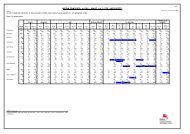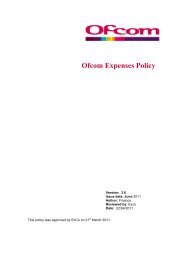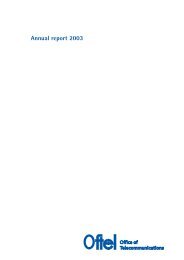WHAT CHILDREN WATCH - Ofcom
WHAT CHILDREN WATCH - Ofcom
WHAT CHILDREN WATCH - Ofcom
Create successful ePaper yourself
Turn your PDF publications into a flip-book with our unique Google optimized e-Paper software.
Introduction<br />
Programming for children on television continues to increase. This report updates the survey<br />
last undertaken five years ago, which covered the period from 1992-1996. 1 This study,<br />
which considers the five years since then, from 1997-2001, shows that the amount of<br />
children’s programming available (as defined by the industry measurement system, BARB)<br />
has tripled. Some of this has come about because of the launch - during that period - of an<br />
analogue, free to air, terrestrial television channel (Five) and some of the change has been<br />
due to the introduction of new satellite or cable delivered channels. In 2002, two further<br />
dedicated channels were introduced, CBBC and CBeebies, available as free-to-air digital<br />
services. The detailed quantitative analysis only presents limited data on these channels,<br />
however, as they were launched after the sample period.<br />
Within the five years under consideration (to 2001), the television landscape has also<br />
changed. Digital services, satellite, cable and terrestrial, have been introduced and DVDs are<br />
taking the pre-recorded content market by storm. As has been found over many years, it is<br />
within homes with children that the newest forms of in-home entertainment are most<br />
quickly adopted.<br />
The sheer volume of targeted children’s programming available means that there is a wide<br />
range of programme types available. However, the data also show, as did the report which<br />
ran from 1992-1996, that the proportions of diverse content are restricted. While a<br />
significant proportion of the material is animation-based, the terrestrial analogue television<br />
channels still provide a more diverse programme line-up, with regard to the balance of<br />
programme types, than the dedicated services available to multichannel homes. This, in<br />
turn, affects the type of material children in multichannel homes are watching in<br />
comparison with children in analogue terrestrial-only homes. The data also show that<br />
children in multichannel homes watch approximately 35 more minutes of television per day<br />
than those in homes without access to additional broadcast channels.<br />
The previous report, by Professor Messenger Davies, had included a series of interviews<br />
with professionals and those interested in children’s programming provision. At that time,<br />
the research had shown the genre to be under pressure, especially as channels competed for<br />
audiences in what were often seen to be lucrative (within commercial television channels)<br />
time slots. Certain programme categories were felt to be at risk and there was general<br />
pessimism, especially among the traditional broadcasting community, about the<br />
continuation of children’s programming. Those interviewed who came from the emerging<br />
satellite and cable industries were far less pessimistic. This study will examine, through the<br />
analysis of programme provision, whether the pessimism or optimism was justified.<br />
However, it also takes on board one of Professor Messenger Davies’s key calls, which was<br />
for children’s opinions to be heard. The study included interviews and discussions with<br />
children aged 6 to 12, asking them about their viewing habits and the importance of<br />
children’s programming in their lives, while also seeking parents’ views about children’s<br />
programme provision.<br />
1 Messenger Davies, M, and Corbett, B., The Provision of Children’s Television in Britain: 1992-1996; Broadcasting Standards<br />
Commission, 1997.<br />
What Children Watch 5

















